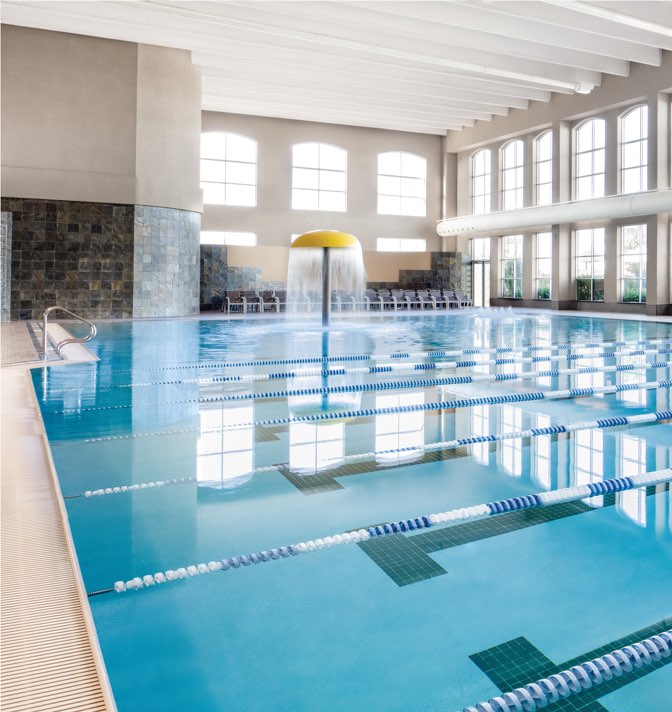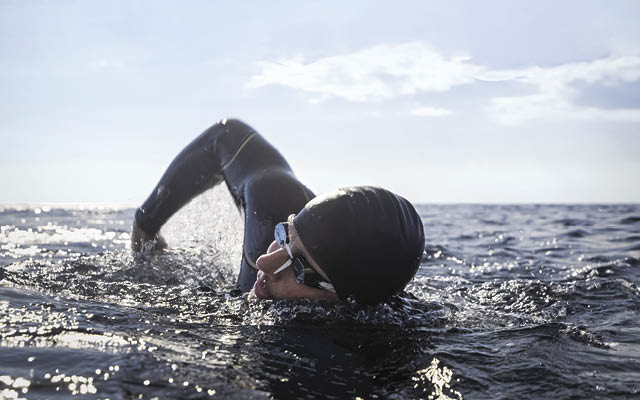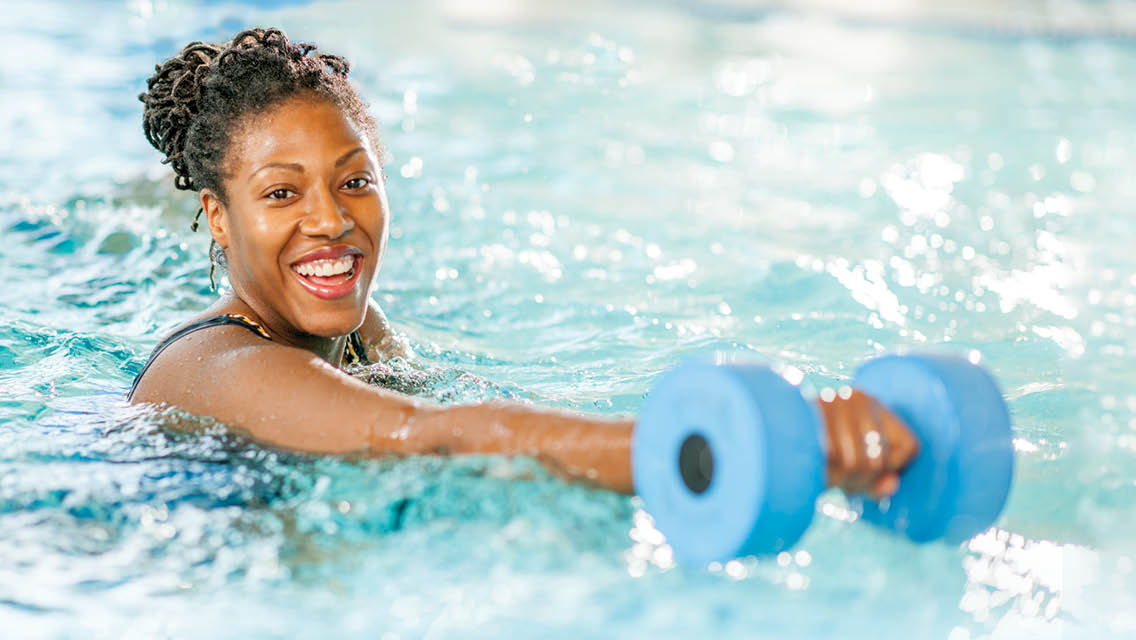Water has long been recognized for its healing and rejuvenating powers. And while we’ve yet to discover any magical fountain of youth, growing evidence suggests that spending some time in conventional pools and lakes can do its own kind of magic: Recent research shows that swimming regularly can greatly delay the onset of some symptoms of aging and declining health.
The results speak for themselves:
Joel Stager, PhD, director of Indiana University’s Counsilman Center for the Science of Swimming, performed a series of tests on 200 swimmers at the U.S. Masters Swimming Short Course National Championships in 2004, measuring typical age markers such as blood pressure, cholesterol, triglycerides, pulmonary function, and muscle mass and strength.
For the general population, the numbers in such areas usually worsen by as much as 1 percent per year beginning around age 35. But for this sample of adult swimmers, who log 3,500 to 5,000 yards each day (about 140 to 200 lengths of a standard 25-yard pool), the results were encouraging in each category. The swimmers maintained their health and fitness as they got older.
In fact, these 50-year-olds had the physiological function of people 20 years younger.
Granted, not every swimmer has the same workout regimen or ability level as participants in a national masters swimming competition, but Stager insists that the benefits of swimming are universal. And the good news is that even those who haven’t already been swimming for years can still see results over time by starting a swimming regimen now.
“For one thing, swimming helps maintain muscle mass. That’s important because as people lose muscle, they gain fat and lose strength, which can leave them unable to perform even simple, everyday tasks,” Stager explains. “And since muscle responds to exercise regardless of age, it’s never too late to start.”
A Sport for the Ages
While building muscle can be done through a variety of exercise routines, swimming has long been thought of as a lifelong sport because it’s low impact (it doesn’t strain or stress joints the way more jarring activities like running can), yet it still provides a full-body aerobic workout. Although swimmers sometimes experience shoulder injuries, they don’t typically have back, hip or knee pain. That makes swimming ideal for people who want to stick with a healthy fitness routine over a long period of time.
“As you get older, you have to address injuries right away, because it’s often more difficult to recover. And swimming is usually an activity you can continue during rehab.”
Rob List, a 51-year-old New Jersey native, attests that swimming has kept him active through the years. He began swimming as a child, and even as he’s participated in other sports, including football as a teenager and marathons as an adult, he’s maintained the activity as a component of his exercise routine. He likes the way it loosens his muscles, which are often tight from running, and credits swimming as one of the major reasons he’s able to continue a vigorous fitness program.
“As you get older, you have to address injuries right away, because it’s often more difficult to recover,” he says. “And swimming is usually an activity you can continue during rehab.”
Water Workout
While consistency is the best policy, as with any form of exercise, certain tools can help you maximize your efforts in the pool. Using a heart-rate monitor while swimming, for instance, bumps up the benefits by indicating how hard you’re working.
If you know your anaerobic threshold, you can tell whether you’re training your body for aerobic endurance or speed, as well as what type of fuel you’re burning (to learn more about heart-rate training, see “How to Find Your Anaerobic Threshold“). Some heart-rate monitors don’t work well in water, however, so you might have to track your heart rate the old-fashioned way: either by counting your pulse for six seconds, then adding a zero to the number, or by counting your pulse for 10 seconds, then multiplying that number by six.
Stager, who also helps coach his local masters swim club, is a proponent of adding diversity to workouts. His recommendation: Focus on continuous, moderate intensity some days; on others, pay attention to speed, and work at the edge of your cardiovascular capacity. As in many endurance sports – like running, for example – having some sessions dedicated to speed will help build strength, while aiming for distance in other workouts will improve cardiovascular endurance.
The subjects Stager studied, all members of masters swim teams, usually practiced five times per week for an hour or more, averaging at least 3,000 total yards per session. Typical workouts included a warm-up with about 500 yards of stroke drills, kicking and combinations of different strokes.
After that, they completed a “main set,” which included swimming a certain distance in intervals. For example, swimmers did three sets of five 200-yard freestyle swims, each to be completed in three minutes. They got to rest for just a few seconds between intervals, with a longer period of rest between sets.
Their goal was to complete each set more quickly than the previous one. Sometimes practices included a second main set, and they always included a cool-down (usually a slow swim of about 300 yards).
To see the kind of health benefits that emerged in his study, however, he recommends swimming 2,000 to 4,000 yards three to five times a week.
Before hopping into the pool for a few main sets of your own, however, it’s helpful to determine your goals. Stager asserts that for recreational swimmers – especially for those who have been otherwise inactive – any amount of regular swimming is beneficial. To see the kind of health benefits that emerged in his study, however, he recommends swimming 2,000 to 4,000 yards three to five times a week. Workouts that increase yardage as time goes on will improve overall fitness and also improve health markers like muscle mass.
For swimmers training for an event, such as a triathlon, doing intervals with minimum rest – such as sets of 10 100-yard swims with 10 seconds rest in between – will go a long way toward getting you ready to compete.
Master Your Swim Form
A key to getting the most out of your time in the pool, according to Terry Laughlin, founder of Total Immersion Swimming and author of Swimming Made Easy, is to learn proper form.
Swimming is highly technical, and even physically fit newcomers are sometimes frustrated because they waste a lot of energy swimming inefficiently – their lack of technique has them floundering across the pool, and they tire out quickly. Laughlin has made it his mission to teach people to swim like fish instead of doing what he calls “human swimming,” where people overemphasize pulling and kicking instead of streamlining and balancing in the water (see “Tips for an Efficient Freestyle Technique,” below).
Laughlin practices what he preaches.
From 1992 to 2005, he experienced a slight decline in his swimming performance each year. That is, until this year – when, at age 55, he began swimming faster than he had in 10 years.
He credits the performance boost to technique improvements. He began concentrating on how he moved in the water, rather than how fast he went. He made sure that he was quiet – the less splash he made, the better. “I’m learning that, to a far greater extent in water than on land, an increase in attention to form can more than compensate for any decrease in aerobic capacity and strength,” Laughlin says.
As a result of his practice, Laughlin set some new goals.
This summer, he plans to break the U.S. Masters national two-mile cable-swim record in his age group at the champion-ships in Charlottesville, Va. Then, after getting the 28.5-mile Manhattan Island Marathon Swim under his belt, he’ll also compete in the two-mile cable swim in New York, which is a back-and-forth swim between two buoys set a quarter of a mile apart. (Thanks to masters divisions in many sports, older athletes are finding fun new ways to get and stay fit. See “Unlock Your Fitness Potential as a Master’s Athlete” for more.)
Not everybody needs to set such lofty goals, of course. Merely dedicating yourself to a weekly swimming routine will lead to greater health-related rewards in the long run. “Swim as often as you have an appetite for it,” Laughlin advises. “My experience has taught me that swimming always feels rewarding.”
Tips for an Efficient Freestyle Technique
Why do some people seem to glide effortlessly through the water while others splash and thrash from one side of the pool to the other, wheezing by the end of a single lap?
Generally, people who have taken time to work on their freestyle stroke technique before diving into a weekly workout program are able to swim faster – and more gracefully.
Terry Laughlin, founder of Total Immersion Swimming and author of Swimming Made Easy, offers these do’s and don’ts for becoming a more efficient swimmer.
→ Do “hang” your head.
Release its weight to find the most natural position. Don’t force your head down, and don’t hold it up, either.
→ Do lengthen your body.
This will reduce drag and allow you to swim faster, easier. Slip your arm, fingers first, into the water as if sliding it into a sleeve, lengthening your arm as your fingers slide into the water.
⊗ Don’t splash.
Swim as smoothly as possible, disturbing the surface of the water as little as possible. Water rewards fluid movement and penalizes rough or rushed movement.
⊗ Don’t focus so much on heart rate as you do on how many strokes you take per lap.
In general, if you take more than 20 strokes per length of a 25-yard pool, you can improve your efficiency by concentrating on streamlining and lengthening your body as you move through the water.
Diving In
Ready to make a splash at the local pool?
Here are a few ways to get started on a simple program of your own, based on suggestions by United States Masters Swimming member Bill Volckening in It’s Never Too Late: Personal Stories of Staying Young Through Sports by Gail Waesche Kislevitz.
- Seek help. Swimming is more technical than many other sports. An instructor or coach can offer helpful suggestions about how to improve your form and technique.
- Start smart. Start with two or three swims a week and build from there. The first week, make it your goal to alternate swimming for 30 seconds and then resting for 30. Most people can make it to the other end of a standard 25-yard pool in 30 seconds, but if not, stop and rest at the edge of the pool. Repeat 10 times. Make sure to rest long enough to catch your breath, even if it takes longer than 30 seconds. (For more on how to breathe while swimming, check out “Expert Answers: Breathing Tips for Swimming.”)
- Join a club. Swimming doesn’t have to be a solitary endeavor. Having the support of a team may help keep you dedicated to the routine. Even finding a partner or another group of like-minded fitness buffs can do the trick.
This article originally appeared as “Swim for Your Life!”





This Post Has 0 Comments